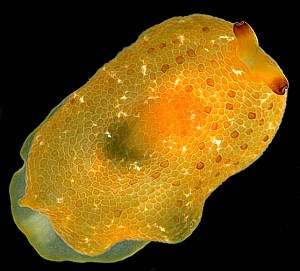
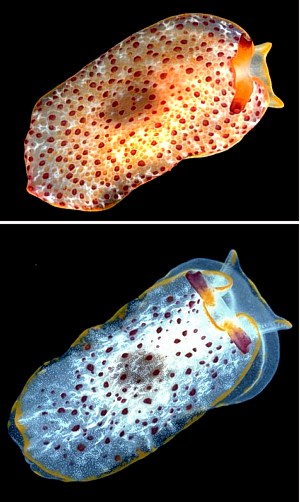
Pleurobranchus peroni
Cuvier, 1804
Order: NOTASPIDEA
Superfamily: PLEUROBRANCHOIDEA
Family: Pleurobranchidae
PHOTO
UPPER: Adult, Koumac, New Caledonia, October 1993, 28mm long. (grows to at least 60mm).
MIDDLE: North Coast, New South Wales, Australia, March 1982, 20mm, showing intermediate colour form.
LOWER: Juvenile, Coffs Harbour Region, New South Wales, Australia, December 1990, showing typical juvenile colouration.
PHOTOS: Bill Rudman.
Very common widespread Indo-West Pacific species ranging in background colour from a pale translucent white, through yellow and brown to a deep purple. The mantle is covered in small tubercles each outlined by a polygon which is either deeper in colour than the background colour, or sometimes white. Juvenile specimens are usually distinctly different in colour with a translucent white background, some of the tubercles tipped with reddish purple and the mantle edged in orange or red. This colour form has been considered to be a distinct species (P. ovalis - Pease, 1868: Pruvot-Fol, 1954; Thompson, 1970; P. papillatus Risbec, 1951). As the animal grows, all the tubercules gradually colour, from the tip down, and the purple fades from the scattered purple-tipped tubercles. The various colour forms from juvenile to adult are similar to the juvenile forms of Pleurobranchus grandis but they can be distinguished by the absence of the white reticulate pattern in P. peroni. There are probably other names which have been given to this species, but the variable colour pattern, and ambiguous early descriptions, make identification difficult. Pleurobranchus zeylanicus Kelaart, 1859, Oscaniella nigropunctata Bergh are clearly this species as are two other species described from South Africa (Pleurobranchus inhacae Macnae,1962; Pleurobranchus xhosa Macnae, 1962) which are said to differ from P. peroni in the size of the prostate gland, much larger in P. peroni. Both appear to be juvenile specimens, which would explain the less developed prostate gland. Susania papillosa,is a another name given to a specimen from southern Africa, is most probably a purple colour form of this species. Pease (1868) reported this species from Tahiti (P. ovalis) and Risbec (1951) from New Caledonia (P. papillatus). It is unlikely that there is a name earlier than Cuvier's.
Reference:
• Cuvier, G.L. (1804). Mémoire sur la Phyllidie et sur le Pleurobranche, deux nouveaux genres de mollusques de l'ordre des gastéropodes, et voisins des patelles et des oscabrions, dont l'un est nu dont l'autre porte une coquille cachée. Annales du Muséum National d'Histoire Naturelle, Paris, 5: 266-276.
Rudman, W.B., 1999 (April 18) Pleurobranchus peroni Cuvier, 1804. [In] Sea Slug Forum. Australian Museum, Sydney. Available from http://www.seaslugforum.net/find/pleupero
Related messages
Colour in Pleurobranchus peroni from Reunion Is.
September 22, 2008
From: Hugues Flodrops
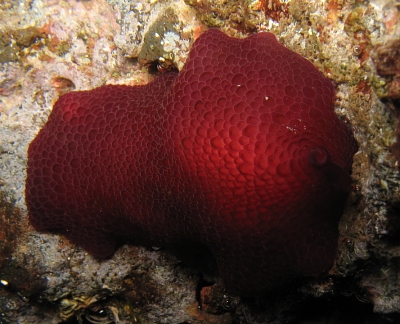
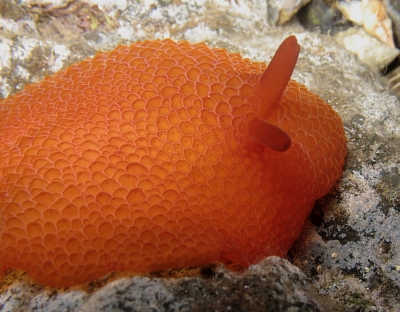
Dear Bill,
After reflection, I think that the animal in my preceding message [#21012] is an yellow-orange form of Pleurobranchus peroni. Here are three pictures to illustrate the variation.
Upper: Dark red form. Specimen size about 60 mm, 30 April 2007 by night. Middle: Orange form. Specimen size more than 80 mm. Date observed 22 August 2007. Lower: Yellow-orange form. Specimen size 35 mm. Locality: Etang-Salé , 1 metre, Reunion Island, Indian Ocean, 30 april, 22 august and 19 October 2007, Night. Length: 60- 80 and 35 mm. Photographer: Hugues Flodrops.
Thanks for your thoughts.
Best regards.
Hugues.
hugues.flodrops@wanadoo.fr
Flodrops, H., 2008 (Sep 22) Colour in Pleurobranchus peroni from Reunion Is.. [Message in] Sea Slug Forum. Australian Museum, Sydney. Available from http://www.seaslugforum.net/find/21014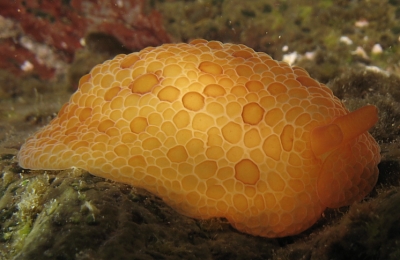
Dear Hugues,
Yes this is a very variable species in colour. If you look at the Fact Sheet, I mention quite a few names that various colour forms of this species have been given in the past
Best wishes,
Bill Rudman
Pleurobranchus peroni from Reunion Island
September 22, 2008
From: Hugues Flodrops
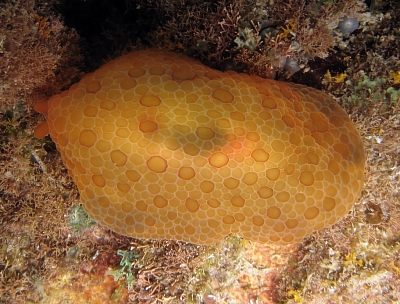
Dear Bill,
Could you confirm please the ID of this Pleurobranchus. Is it Pleurobranchus sp.1 of the forum or another identification?
Locality: Etang-Salé near "the gouffre", 1 metre, Reunion Island, Indian Ocean, 16 october 2007, By night. Length: 35 mm. Photographer: Hugues Flodrops.
Best regards and sorry for the work.
Hugues.
hugues.flodrops@wanadoo.fr
Flodrops, H., 2008 (Sep 22) Pleurobranchus peroni from Reunion Island. [Message in] Sea Slug Forum. Australian Museum, Sydney. Available from http://www.seaslugforum.net/find/21012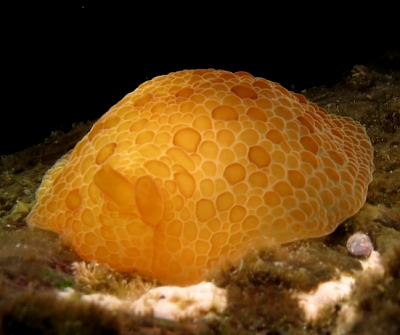
Dear Hugues,
This is Pleurobranchus peroni.
Best wishes,
Bill Rudman
Pleurobranchus peroni from the Seychelles
September 18, 2007
From: David Barnes
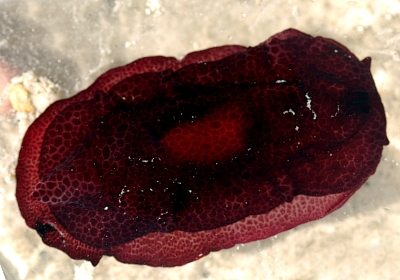
Dear Bill,
I assume this is a species of Pleurobranchus, if so can you tell which from the two pics - sorry there is not a ventral one. It was found in the intertidal amongst sandy boulders. Thank you for the help.
Locality: Silhouette Is., Lower shore, Seychelles, Indian Ocean, August 2007, Intertidal, sand & boulders. Length: ~6 cm. Photographer: Richard Barnes & Tom Peschak.
Richard Barnes
dkab@bas.ac.uk
Barnes D.K.A., 2007 (Sep 18) Pleurobranchus peroni from the Seychelles. [Message in] Sea Slug Forum. Australian Museum, Sydney. Available from http://www.seaslugforum.net/find/20744
Dear Dave,
This is Pleurobranchus peroni, a widespread species in the Indo-West Pacific. As you will see on the Fact Sheet the species is quite variable in colour, and individuals change colour during their lifetime. This has resulted in many names being given to the species.
Best wishes,
Bill Rudman
Re: Pleurobranchus peroni from N. Sulawesi
December 15, 2006
From: Ron Velarde
Concerning message #18662:
Hi Bill,
You wrote " The internal shell in this species is transparent and only thinly calcified. It usually stops growing once it reaches about 7 or 8 mm in length, and in animals larger than about 6 cm it is often absent." Is this typical of the various species of Pleurobranchus?
Pleurobranchus and Pleurobranchaea are closely related genera and I thought one of the major differences was whether a shell was present (Pleurobranchus) or absent (Pleurobranchaea ). So in the description above, if the shell is absent, wouldn't that make this a species of Pleurobranchaea?
If possible, it would be nice if you could post a list of references that review the aspect of the shell in opisthobranch taxonomy.
Thank you for all you do for the forum!
Ron
rvelarde@sandiego.gov
Ron Velarde, 2006 (Dec 15) Re: Pleurobranchus peroni from N. Sulawesi. [Message in] Sea Slug Forum. Australian Museum, Sydney. Available from http://www.seaslugforum.net/find/19022Dear Ron,
Some months ago I almost finished a number of Fact Sheets on the 'notaspids' but unfortunately there are only 24 hours in the day. I have had a quick look at them and they are so close to finishing that your message may in fact be the catalyst I need to do so. They are like the set I have done for the 'anaspids' [see General Topics list] and cover the higher taxonomic levels and some basic anatomical features.
Concerning your specific queries, the shell in at least some species of Pleurobranchus certainly seems to reach a limited size and seems to disappear as animals reach a large size. It is possible that the apparent disappearance in large animals - such as 300 mm long P. forskalii - could be from it dissolving or breaking into small fragments in preserved animals, but I remember once trying to find shells in 15 cm long P. forskalii by rotting them in sea water - changing the water regularly so the water would not become too acidic - and ending up with jaw plates and radula but no sign of shells.
Pleurobranchaea is shell-less, but the best way to distinguish it externally is from the very reduced mantle skirt and the position of the rhinophores which are placed far apart on either side of the head [see P. maculata ]. In other pleurobranchs, the rhinophores are close together in a median position.
The shell in opisthobranchs is an enormous story. I will look out some references. While it is useful in some groups, in others it is often an impediment to identification. For example, in some cases, such as Retusa, Cylichna and Tornatina, it is often impossible to know from the shell even which family the species belongs to. Many shelled opisthobranchs were named by conchologists in the 1800s with a very 'conchocentric' view of the world, who felt their job was done by describing dead shells - often very poorly. Without photographs, the line drawings are often useless for identfications, and if the type is lost, we are lost when it comes to interpreting the name. Even when living animals are available, researchers can be blinded by the shell into making incorrect identifications.
A perfect example from the east coast of Nth America concerns some species of Acteocina. Wells & Wells (1964) described what they thought were the shell and radular differences between Acteocina candei and Retusa canaliculata and the direct development of R. canaliculata. Franz later described a planktonic larval stage for Acteocina canaliculata which led to the assumption that A. canaliculata exhibited peocilogeny [variable development strategies]. I won't go into all the following confusion but it was finally resolved by Paula Mikkelsen who showed on anatomical grounds that Wells & Wells' 'Retusa canaliculata' which was of course never a Retusa because it had a radula, was a third species of Acteocina. In this case the shells all turned out to be from one genus but in many cases its not as simple.
Another problem is internal shells. Sometimes we can't successfully identify a species from the outside alone. For example, while revising the Philinidae in New Zealand (Rudman, 1970) I discovered that when Suter described Philine auriformis he did not choose a holotype from his type series of specimens. In this type series of specimens I found two further species, both undescribed, from two genera, Philine powelli and Melanochlamys lorrainae. In this case the shells were quite different, but because they were reduced and internal, they were unnoticed.
I should stop before this becomes a book in itself - but I promise to try and get the 'notaspid' Fact Sheets posted before the end of the year.
- Franz, D.R. (1971) Development and Metamorphosis of the Gastropod Acteocina canaliculata (Say). Transactions of the American Microscopical Society, Vol. 90: 174-182.
- Mikkelsen, P.S. and P.M. Mikkelsen. (1984) Comparison of Acteocina canaliculata (Say, 1826), A. candei (d'Orbigny, 1841), and A. atrata spec. nov. (Gastropoda: Cephalaspidea). The Veliger, 27(2): 164-192.
- Rudman,W.B. (1970) A revision of the genus Philine in New Zealand with descriptions of two new species (Gastropoda, Opisthobranchia). J. Mal. Soc. Aust., 2(1): 23-34.
- Wells, H.W. & Wells, M.J. (1962) The distinction between Acteocina candei and Retusa canaliculata. The Nautilus, 75: 87-93.
Best wishes,
Bill Rudman
Re: Pleurobranchus peroni from N. Sulawesi
December 13, 2006
From: Hugues Flodrops
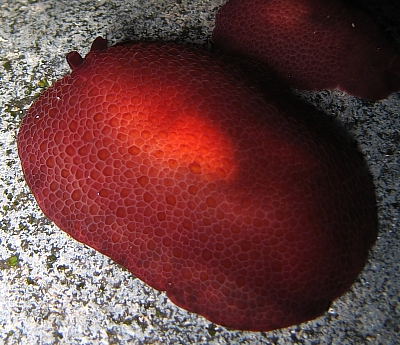

Concerning message #15349:
Dear Bill,
Here are photos of what Philibert Bidgrain think are Pleurobranchus peroni.
Locality: Côte Rocheuse, Etang-Salé, 0,8 metre, Reunion Island, Indian Ocean, 25 Novembre 2006, Two hours after nightfall. Length: 80 mm and 40 mm. Photographer: Hugues Flodrops.
It's seems the animals are afraid of the light. What are the differences between pleurobranchs and nudibranchs?
Is the orange spot a sign of a small internal shell?
Thanks for your comments.
Regards.
Hugues
hugues.flodrops@wanadoo.fr
Flodrops, H., 2006 (Dec 13) Re: Pleurobranchus peroni from N. Sulawesi. [Message in] Sea Slug Forum. Australian Museum, Sydney. Available from http://www.seaslugforum.net/find/18662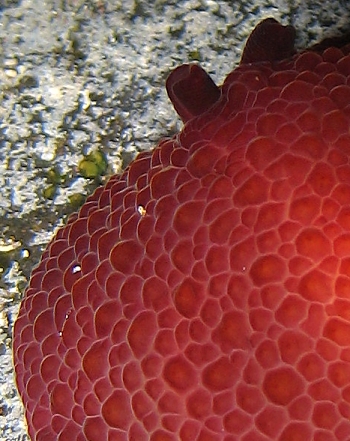
Dear Hugues,
Yes this is a dark form of P. peroni. I have added a close-up alongside showing the nature of the tubercles over the mantle and also the rhinophores or head tentacles. You will notice that these tentacles are formed from the rolling of the tissue into an open tube, much as found in many sacoglossans. Many opisthobranchs are what we call photo-negative, which means they have a tendency to avoid the light. It is why they are often more abundant at night than during the day. This behaviour is normally considered to be a defensive mechanism to avoid being eaten by predatory fish, but in intertidal animals it also a useful measure to stop drying out or getting overheated in the sunlight.
Recent studies are suggesting that the pleurobranchs are quite closely related to the nudibranchs. In the past the Notaspidea [Pleurobranchs + Tylodinoidea] were considered a distinct group of opisthobranchs, just as are the Cephalaspidea [bubble-shells etc], Sacoglossa and the Nudibranchia. It now seems that the Nudibranchs and the Pleurobranchs (but not the Tylodinoidea), have a common evolutionary origin and the term Nudipleura has recently been coined for them.
Two obvious characters which separate the pleurobranchs from the nudibranchs are the enrolled head tentacles and the large gill found along the right side of the body in pleurobranchs. In nudibranchs the head tentacles [ rhinophores] have a very distinctive shape, and the gills, if present, form a circle in the dorsal midline.
Concerning the pale orange patch in the middle of the back. I think this is just a patch of skin in which the pale gonad is showing through. The internal shell in this species is transparent and only thinly calcified. It usually stops growing oonce it reaches about 7 or 8 mm in length, and in animals larger than about 6 cm it is often absent.
Best wishes,
Bill Rudman
Pleurobranchus peroni from eastern Australia
December 7, 2006
From: Linda Mougeot

Hi Bill,
While exploring the rocks pools of Bateau Bay, New South Wales I came across a specimen of sea slug(?) that I have not been able to identify in any of my guides. I was wondering if you could shed some light on what species this may be?
Locality: Bateau Bay , NSW, Australia, South Pacific Ocean, 25 November 2006, Less than 20 cm in tidal rock pool. Length: 8 cm. Photographer: Linda Mougeot.
Kind Regards,
Linda
ornithforensic16@hotmail.com
Mougeot, L., 2006 (Dec 7) Pleurobranchus peroni from eastern Australia. [Message in] Sea Slug Forum. Australian Museum, Sydney. Available from http://www.seaslugforum.net/find/18898
Dear Linda,
This is Pleurobranchus peroni known in some places as the polygon slug because of the way the edge of the tubercles are often outlined in a darker colour to give a pattern of polygons over the back. You will see this better in some of the photos of other messages on this species. Pleurobranchs are commonly called side-gilled slugs because they have one large gill on the right side of the body under the mantle skirt.
Best wishes,
Bill Rudman
Pleurobranchus peroni mating?
May 4, 2006
From: James Spears
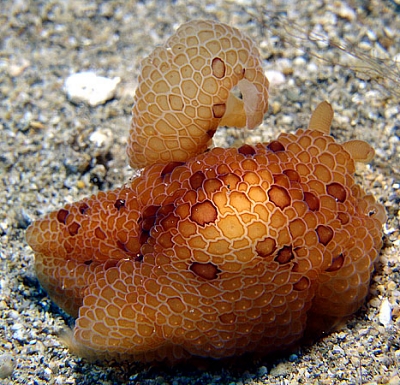
Is it safe for me to assume the two Polygon Pleurobranchs are mating/about to/finished in the attached photo?
Locality: Maui, Hawaii, 60 feet, US, Pacific, 7 April 2006, patch reef. Length: unknown. Photographer: Jim Spears.
Jim Spears
islandjim@gmail.com
Spears, J., 2006 (May 4) Pleurobranchus peroni mating?. [Message in] Sea Slug Forum. Australian Museum, Sydney. Available from http://www.seaslugforum.net/find/16486Dear Jim,
The polygonal markings seem to be very distinctive in Hawaiian specimens of Pleurobranchus peroni. I have already discussed today [see message #16517] why I don't like using common names so I won't bore you again.
Concerning the apparent mating. I have looked very carefully at your photo and what I think is happening is that there is only one animal and it is casting off part of its mantle (left side). Some opisthobranchs can cast off part of their bodies like this [see Autotomy Fact Sheet] much like some lizards can drop their tails. There is another pleurobranch, Berthella martensi, which seems to do it more than most other pleurobranchs. I can't recall seeing P. peroni doing this before, but that may be my memory letting me down.
It is an interesting photo
Best wishes,
Bill Rudman
Pleurobranchus peroni from N. Sulawesi
December 5, 2005
From: Linda Ianniello
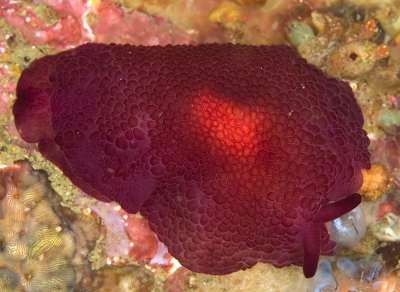
I believe this is a Pleurobranchus peroni which shows good detail of the texture. The forum doesn't have very many shots of this subject.
Locality: Lembeh Strait, Nudi Falls dive site. Indonesia, Sulawesi Island. October 28, 2005. Photographer: Linda Ianniello
Regards,
Linda I.
lindai1@bellsouth.net
Ianniello, Linda, 2005 (Dec 5) Pleurobranchus peroni from N. Sulawesi. [Message in] Sea Slug Forum. Australian Museum, Sydney. Available from http://www.seaslugforum.net/find/15349
Dear Linda,
Thanks for the nice shot of the polygonal pustules, which although present to some extent in most species of Pleurobranchus, are particularly well-developed in P. peroni.
Best wishes,
Bill Rudman
Re: Mystery slug from Malaysia
May 11, 2005
From: Roberto Sozzani
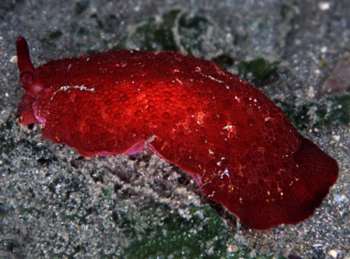
Dear Bill,
If I can add something more to the mystery [message #13735 ], here is a very similar specimen, from Indonesia.
Locality: Secret Bay, Bali. Indonesia. Depth: 5 metres. Length: 100-120 mm. March 2003. muddy and dark sand. Photographer: Roberto Sozzani
Roberto
roberto.sozzani@fastwebnet.it
Sozzani, R., 2005 (May 11) Re: Mystery slug from Malaysia. [Message in] Sea Slug Forum. Australian Museum, Sydney. Available from http://www.seaslugforum.net/find/13744Dear Roberto,
Thanks for this. I am pretty sure your animal is Pleurobranchus peroni. As I said earlier it is very similar colour form to P. forskalii, but doesn't appear to grow as large. In your photo you can see the scattered, slightly larger papillae, appearing almost as a darker brown ring, which are characteristic of P. peroni. At 10 - 12 cm, it is a large specimen of the species.
Best wishes,
Bill Rudman
Pleurobranchus peroni from Indonesia
December 11, 2003
From: H.Haluk Akbatur
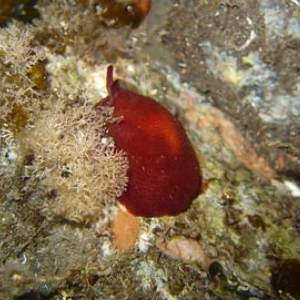
Dear Bill,
On a recent visit to Indonesia I found three different pleurobranchs but can only identify one - Euselenops luniceps. [see message 1, message 2]
They were all seen on 18 November 2003, Dive site: Just front in (North-east of Bali, Amlapura, Scuba Seraya Resort,] Size: 5 cm. Depth: 3-15m.
Thanks for any help in identifying them.
H. Haluk Akbatur
Lasergoz@ttnet.net.tr
Akbatur, H.H., 2003 (Dec 11) Pleurobranchus peroni from Indonesia. [Message in] Sea Slug Forum. Australian Museum, Sydney. Available from http://www.seaslugforum.net/find/11654Dear Haluk,
I am pretty sure this is Pleurobranchus peroni. It is a bit hard to be sure but its size and lack of distinctive markings would seem to suggest this species
Best wishes
Bill Rudman
Pleurobranchus peroni from Jervis Bay
November 12, 2003
From: Sue Newson


To accompany my last message, here are some photos of Pleurobranchus peroni from Jervis Bay.
They show the underside of Pleurobranchus peroni, after it had been accidently knocked from the reef by the water movement of a passing fin (my buddy's) and I photographed it as it 'fluttered' down like a falling leaf or feather, than like a parachute once the water movement stopped.
Site: Nursery Steps - Jervis Bay, NSW, Australia
30 November 2002 8.30pm - 9.30pm
Depth: 15m
Water temp 18*C
Sue Newson
snewson@shoal.net.au
Newson, S., 2003 (Nov 12) Pleurobranchus peroni from Jervis Bay. [Message in] Sea Slug Forum. Australian Museum, Sydney. Available from http://www.seaslugforum.net/find/11382Thanks Sue,
Although this species is not a recognised 'swimmer', most pleurobranchs will stretch out their mantle like this when dislodged. Some species, like the Atlantic Pleurobranchus membranaceus are well-known 'swimmers'.
Best wishes
Bill Rudman
Pleurobranchus peroni - Jervis Bay
October 24, 2003
From: Sue Newson
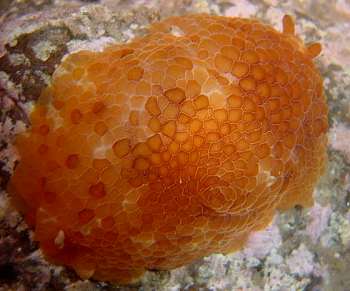
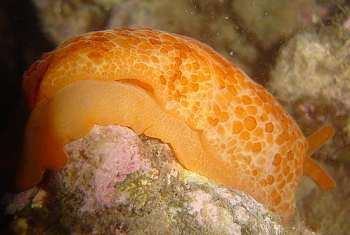
Hi Bill,
Reading the latest message re: Pleurobranchus peroni reminded me of a couple of dives when I came across them.
The first one was at a site called "Dent Rock", a personal favourite of mine [Jervis Bay, New South Wales, Australia].
It is a pile of ballast rock dumped in the late 1800's about 150m from shore. The highest point lies beneath the surface from .5m - 2m with a max depth of 5-7m, tide dependent. This isolated reef is abundent with many various species of marine life, many of which are residents that I am beginning to recognize through repeated sightings. Unfortunately I can't say that about the opistobranchs. Those sightings vary in species and abundance.
The night I saw Pleurobranchus peroni for the first time, there was many different species in large numbers. They also included: Umbraculum umbraculum and Berthellina citrina as well as a few snails. I have attached photo's that I took that night but unfortunately I didn't get a photo of Umbraculum umbraculum due to a fogged lens at the end of the dive.
Dive details:
Site: Dent Rock, Jervis Bay
22 November 2002 9.30pm - 10.30pm
average depth: 3m (where pleurobranchs were found)
Viz 2m in torch light.(good for this spot)
Water temp: 19*C
Low tide
Sue Newson
snewson@shoal.net.au
Newson, S., 2003 (Oct 24) Pleurobranchus peroni - Jervis Bay. [Message in] Sea Slug Forum. Australian Museum, Sydney. Available from http://www.seaslugforum.net/find/11303Thanks Sue,
I am sure I don't need to say it, but photos of eggs and feeding are always welcome. I don't know why species of Pleurobranchus seem to occur in quite large numbers and then disappear, but it certainly makes it difficult to plan a study of their natural history
Best wishes
Bill Rudman
Pleurobranchus peroni from Sunshine Coast
October 21, 2003
From: Gary Cobb
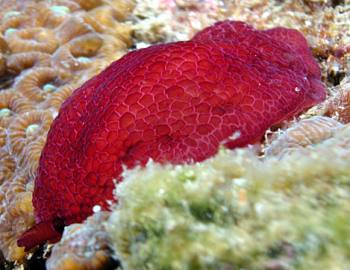
Hi Bill,
I am having trouble IDing some of my photos.
Location: Off Mooloolaba, Sunshine Coast, Queensland, Australia
Site: Clown Reef
Depth: 11m
Length: 60mm
Date: August 2003
Day time
Many thanks again,
Gary Cobb
gary@cobb.com.au
Cobb, G., 2003 (Oct 21) Pleurobranchus peroni from Sunshine Coast. [Message in] Sea Slug Forum. Australian Museum, Sydney. Available from http://www.seaslugforum.net/find/11063Dear Gary,
This is Pleurobranchus peroni
Best wishes
Bill Rudman
Juvenile Pleurobranchus peroni
May 23, 2003
From: Leanne & David Atkinson
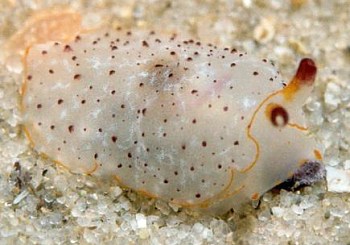
Dear Bill,
We found this sidegill slug at Fly Point, Port Stephens, New South Wales, Australia in 8 metres in November, 2002. Any guesses what it is?
Cheers,
Leanne & David Atkinson
atk@hunterlink.net.au
Atkinson, L. & D., 2003 (May 23) Juvenile Pleurobranchus peroni. [Message in] Sea Slug Forum. Australian Museum, Sydney. Available from http://www.seaslugforum.net/find/9872Dear Leanne & David,
I can do better than a guess. It's a juvenile Pleurobranchus peroni. Have a look at the Species Fact Sheet where I have a number of photos showing the colour changes from juvenile to adult.
Best wishes,
Bill Rudman
Pleurobranchus peroni from Cook Islands
December 2, 2002
From: Sonja Miller

Kia orana Bill,
Is this picture what I think it is - Pleurobranchus peroni? It is from the southern Cook Islands - sorry but we don't have any information about depth, substrate etc... as the photo was taken a few years ago and we've only just dug it out from the files and are trying to give it a name.
Cheers,
Sonja Miller
gerald@nature.gov.ck
Miller, S., 2002 (Dec 2) Pleurobranchus peroni from Cook Islands. [Message in] Sea Slug Forum. Australian Museum, Sydney. Available from http://www.seaslugforum.net/find/8480Dear Sonja,
Yes this looks like P. peroni. I think this is the first message on the Forum from the Cook Islands. Situated almost due south of Hawaii, midway between Australia and South America, the marine fauna of the Cook Islands is of interest as it is at the eastern extreme of what we call the Indo-West Pacific faunal region. Any more information you can provide on the opisthobranch fauna will be very welcome.
Best wishes,
Bill Rudman
Pleurobranchus peroni from southern Korea
November 18, 2002
From: Dong Bum, Koh

Dear Bill,
Here are 3 photos of what I thinl is Pleurobranchus peroni. But they have different color pattern. Are there all the same species or not?
All photos taken from Moon islet. During summer season at night diving.
10m depth. Photographer: Dong Bum, Koh
Best regards,
Dong Bum, Koh
drkoh@seasee.co.kr


Dear Dong Bum,
Yes I would consider these to all be varieties of P. peroni.
best wishes,
Bill Rudman
Juvenile Pleurobranchus peroni from S. Africa
October 17, 2002
From: Valda Fraser
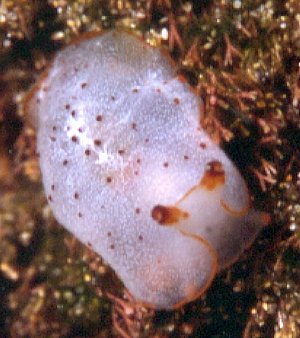
Dear Bill,
This tiny one looks real cute. I like the spots and fine edging. Can you help with identification?
Locality: Pumula, south coast KwaZulu-Natal, South Africa, intertidal zone
Date: August 2002
Size: 10mm
Regards
Valda Fraser
valdafraser@mweb.co.za
Fraser, V., 2002 (Oct 17) Juvenile Pleurobranchus peroni from S. Africa. [Message in] Sea Slug Forum. Australian Museum, Sydney. Available from http://www.seaslugforum.net/find/7861Dear Valda,
This is a juvenile of Pleurobranchus peroni. Have a look at the Fact Sheet for photos showing some of the colour variation found in this species.
Best wishes,
Bill Rudman
The status of Pleurobranchus hirasei
July 25, 2002
From: Nishina Masayoshi
Dear Bill,
Do you think Pleurobranchus hirasei Baba, 1971 is synonym of Pleurobranchus peroni?
Best Regards,
Nishina Masayoshi
nishina@wips.co.jp
Masayoshi, N., 2002 (Jul 25) The status of Pleurobranchus hirasei. [Message in] Sea Slug Forum. Australian Museum, Sydney. Available from http://www.seaslugforum.net/find/7636Dear Nishina,
I would consider this species to be a synonym of A. peroni. Baba notes that in 'general configuration and colouring of the mantle' P. hirasei is very similar to P. peroni and P. albiguttata. However he considers they differ in having the shell embedded in the anterior part of the mantle while in P. hirasei it is in the posterior part of the mantle.
I don't know of any study on the subject but from my experience of pleurobranchs with small internal shells, they can sometimes be absent, sometimes dissolve in preservative, and are somewhat variable in position. It is possible that if there is some dissolving of the shell after preservation then the shell 'cavity' in the skin becomes larger than the shell and allows some movement. There is also quite a bit of body contraction when these animals are preserved, so what is in front of a central point in a preserved animal may have been posterior when it was alive. If all other features are the same, I suspect we should be saying that the shell position in a species is variable rather than using the shell position as the sole character of a species.
• Baba, K. (1971) Pleurobranchus hirasei n.sp., Proposed for a mollusc formerly known as Oscanius testudinarius: Hirase, 1927, from Japan (Opisthobranchia: Notaspidea). Venus, The Japanese Journal of Malacology, 30(1): 23-28,Pl.3.
Best wishes,
Bill Rudman
Juvenile Pleurobranchus peroni
November 2, 2001
From: Nishina Masayoshi
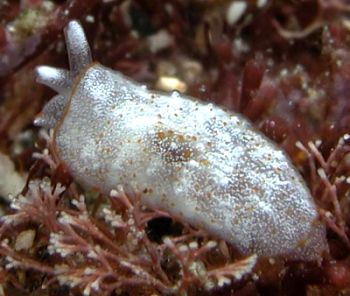
Dr.Rudman,
I attached photos of a juvenile Pleurobranchus peroni.
Date: 21 Oct, 2001
Location: Hachijo Island Japan
Depth: 7m
Length: 5mm
Photo by Nishina Chikako
Best Regards,
Nishina Masayoshi
nishina@wips.co.jp
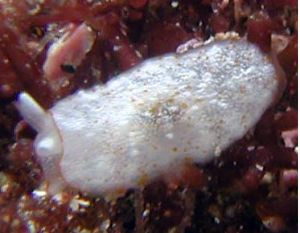

Dear Nishina & Chikako,
Thanks for the photos of this juvenile.
Best wishes,
Bill Rudman
Pleurobranchus from South Africa
August 10, 2001
From: Valda Fraser
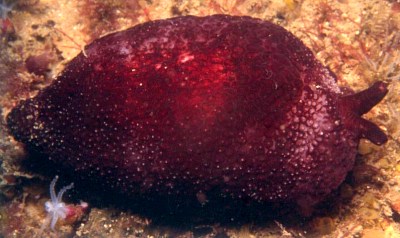
Dear Bill,
Who is this? Hope you have the answer.
Locality: Brazenhead, Eastern Cape, SOUTH AFRICA, 25 m
Date: July 200
Size: 60mm
Valda Fraser
valdafraser@mweb.co.za
Fraser, V., 2001 (Aug 10) Pleurobranchus from South Africa. [Message in] Sea Slug Forum. Australian Museum, Sydney. Available from http://www.seaslugforum.net/find/4865Dear Valda,
I think it's Pleurobranchus peroni, which is very variable in colour throughout its wide geographical range.
Best wishes,
Bill Rudman.
Pleurobranchus peroni from New South Wales
February 24, 2001
From: Patty Jansen

I found and photographed this nudibranch at Norah Head, north of Sydney [New South Wales, Australia]. Although I have seen this animal before, I cannot find a name for it. From the species list at this Forum, it seems most likely to be Rostanga arbutus, but is this correct?
Patty Jansen
capric@capricornica.com
Jansen, P., 2001 (Feb 24) Pleurobranchus peroni from New South Wales. [Message in] Sea Slug Forum. Australian Museum, Sydney. Available from http://www.seaslugforum.net/find/3831Dear Patty,
Your photo is of Pleurobranchus peroni. Rostanga arbutus is a bright orange red colour.
Best wishes,
Bill Rudman
Pleurobranchus peroni from Sydney
March 31, 2000
From: Barbara Harvey

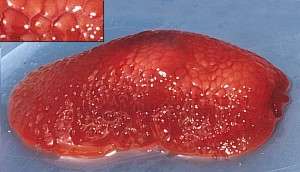
Dear Bill,
Thanks for the last 3 IDs, much appreciated.
Here is a pleurobranch I found at Clovelly pool [Sydney, NSW] on 19 March 2000 under rock in inter-tidal zone. About 6cm long. Can't find anything with hexagon bumps.
TIA
Barbara Harvey
bilby@mpx.com.au
Harvey, B., 2000 (Mar 31) Pleurobranchus peroni from Sydney. [Message in] Sea Slug Forum. Australian Museum, Sydney. Available from http://www.seaslugforum.net/find/2175Dear Barbara,
This is Pleurobranchus peroni, a regular tropical visitor to Sydney. It has quite a range of colour forms and changes colours as it grows. A number of pleurobranchs have hexagonal markings, usually outlining the base of tubercles. An animal from Clovelly, Sydney is not quite as exotic as your least finds from the Galapagos Ids.
Best wishes,
Bill Rudman.
Pleurobranchus peroni from Sth Africa
December 7, 1999
From: Valda Fraser
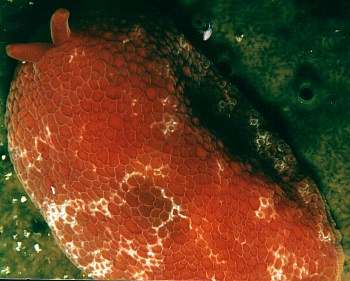
Dear Bill
I don't know if this is a nudibranch or not. It lives under broken bits of coral and rocks. The size variation I have seen is from 20mm - 80mm. I look forward to your response.
Locality: South Coast KwaZulu - Natal, SOUTH AFRICA. Scottburgh - Rocky reef - 24m. November 1999. Size: 70mm
Regards
Valda Fraser
iti04937@mweb.co.za
Fraser, V., 1999 (Dec 7) Pleurobranchus peroni from Sth Africa. [Message in] Sea Slug Forum. Australian Museum, Sydney. Available from http://www.seaslugforum.net/find/1584Dear Valda,
This is a pleurobranch not a nudibranch. Have a look at the other species of the Order Notaspidea in the Species List to get an idea of the variety. They are sometimes called 'side-gilled slugs' because their gill is hidden below the mantle skirt on the right side of the body.
I'm pretty sure that this animal is Pleurobranchus peroni. If you look at the Top of the Page you will see I think a lot of the names given to South African pleurobranchs are colour forms of this species.
Best wishes,
Bill Rudman.
Is this S.African pleurobranch Berthella?
April 18, 1999
From: Ernest C.J. Seamark
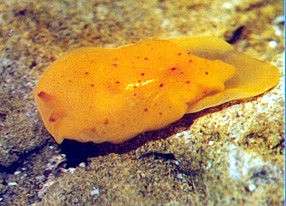
The image attached was ID as Berthella tupala, using Gosliner (1987) The nudibranchs of SA key. Subsequently I've read reports that Berthella tupala is white and not orange/ yellow with orange spots. This specimen was collected in the inter-tidal zone of Treasure Beach, 6km south Durban Harbour, KwaZulu Natal, South Africa. On 15 November 1997. I do not think that this species has been found in South Africa. Do you have any idea of what it is?
Please email me your reply. Thanks for your help.
Ernest C.J. Seamark
kearneyt@biology.und.ac.za
Seamark, E.C.J., 1999 (Apr 18) Is this S.African pleurobranch Berthella?. [Message in] Sea Slug Forum. Australian Museum, Sydney. Available from http://www.seaslugforum.net/find/786Dear Ernest,
This is what Gosliner identifies as Pleurobranchus inhacae Macnae, 1962. Known only from Natal to Mozambique, it seems to be a colour form of Pleurobranchus peroni. See the Top of this Page for pictures showing the colour range found in P. peroni.
Berthella tupala Marcus 1957 was shown by Gosliner & Bertsch, (1988), to be a circumglobal species illustrated in the Sea Slug Forum as Berthella stellata.
Best wishes,
Bill Rudman.
